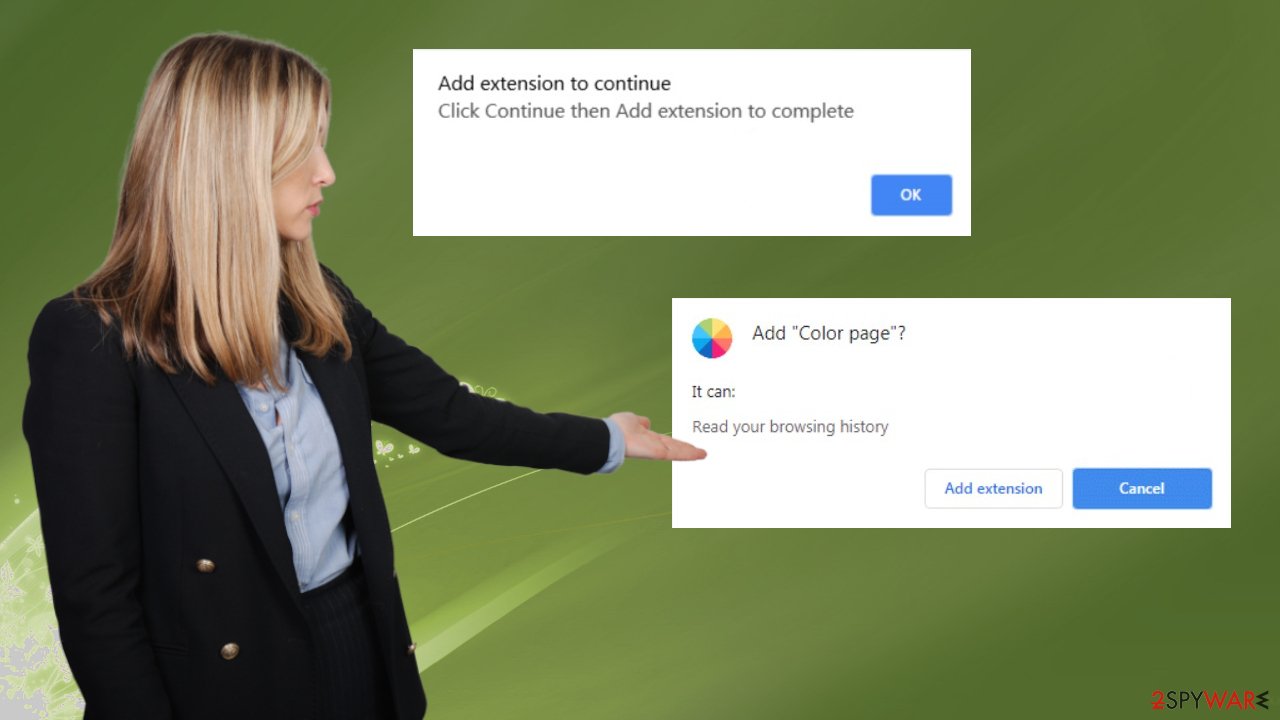Color Page hijacker (Virus Removal Guide) - Improved Instructions
Color Page hijacker Removal Guide
What is Color Page hijacker?
Color Page hijacker – a dubious software that shouldn't be installed

Color Page is falsely advertised as a useful tool when in fact, it's a browser hijacker. If it's installed, it will change your browser's default search engine, new tab, homepage preferences. That's done to generate traffic to affiliated sites by causing redirects and showing deceptive advertisements.
Color Page ads are shown in altered search results that, depending on your geolocation, might come from Yahoo, Bing, or other legitimate sources. They're misleading as their content doesn't match the websites you will be redirected to if you click on them.
Browser hijackers are also capable of gathering non-identifiable information,[1] posing threats to user privacy. It doesn't matter if you installed this potentially unwanted program willingly or you have no idea how it got on your device – we'll explain how to remove it, restore altered system files, and change back the modified browser settings.
| name | Color Page hijacker |
|---|---|
| Type | PUP, browser hijacker, redirect virus |
| Possible browser changes | Default search engine, homepage, new tab |
| Purpose | Generate traffic to affiliated sites by causing redirects and showing search results riddled with ads |
| Symptoms | Search results are shown from a different source that before, new tabs with unknown pages open constantly, browsing speed is reduced |
| Risks | Financial losses, privacy issues, PUP and malware infections |
| Distribution | Software bundles, fake Flash Player updates, deceptive ads, official web stores |
| Removal | If this browser hijacker is installed as an app, use reliable security software to remove it. If it's installed as a browser extension, use our guides posted below |
| System fix | Use the all-in-one FortectIntego system repair software to get your system back on track by deleting all tracking cookies and fixing altered system core files |
There are tons of browser hijackers, and new ones are created very often. They all have similarities, as they all change certain browser settings and show various kinds of ads. Only the affiliated pages and the newly appointed search engines differ.
Browser intruders commonly promote sites that users don't visit of their own volition. That might include sites with explicit, misleading, or hazardous contents, such as:
- push notification viruses,
- porn,
- malware,
- other PUPs,
- gambling,
- tech support scams, etc.
Color Page hijacker could also promote any of these dangerous portals. It could show deceptive ads that have nothing in common with the affiliated websites and cause sudden redirects, where people are forced to visit these pages when a new tab is opened with them.
Furthermore, potentially unwanted programs of this type can collect device details and various browsing habits, such as visited portals, used apps, geolocations, IP addresses, clicked links, etc. Advertisers normally use these details to develop ads specifically for you. But if they got to the wrong hands, you might get in trouble.

Therefore it's unsafe to use any PUP, and you should remove the browser hijacker ASAP if you spot that it's installed on your device or any related symptoms. Expert[2] recommend performing a full system scan with trustworthy anti-malware software such as Malwarebytes or SpyHunter 5Combo Cleaner to eliminate the threat if it was installed as an app.
The scan will also identify, isolate, and remove other threats that might have found their way into your device. Use our free instructions below to eliminate the cyber threat from your browser if it's installed as an extension. Afterward, it's highly recommended to take care of the overall system health by running system diagnostics with the FortectIntego software or similar time-proven system repair tools.
Beware of deceptive ads and fake Flash Player updates
Potentially unwanted programs[3] can sometimes be downloaded from official markets such as Google Chrome Web Store. They are usually falsely advertised as helpful additions to your devices that can improve browsing security, download the latest drivers, remove ads, etc.
In fact, they do the opposite by collecting browsing-related data and causing redirects to websites with questionable contents. Please download software that has many user reviews and is trustworthy. Another method used to spread PUPs and malware is through fake Flash Player updates or installers.

Prompts urging to install/update this software can be seen on shady sites. And since Adobe discontinued support for this software, it will most definitely have malicious installers. Please never download these updates to keep your device virus-free.
Remove Color Page hijacker by using security tools and our comprehensive guides
When your search inquiries are going through an unknown website (or a chain of them), search results are displayed from a different search engine than before, new tabs with questionable pages open out of the blue – you have Color Page virus installed on your device.
It is most likely installed as an app. Therefore scanning your device with dependable anti-malware software will remove it. To be sure, check your browser in use for any unknown extensions/plug-ins. If you see any – delete them. If you're unsure about how that's done, use our free manuals below.
When Color Page hijacker removal is done, a system tune-up is in order to avert any abnormal system behavior, such as BSoDs, severe lag, freezing, etc. You should leave manual Registry and other core system settings modifications to professionals. Regular users should entrust such tasks to time-proven system diagnostics software.
You may remove virus damage with a help of FortectIntego. SpyHunter 5Combo Cleaner and Malwarebytes are recommended to detect potentially unwanted programs and viruses with all their files and registry entries that are related to them.
Getting rid of Color Page hijacker. Follow these steps
Uninstall from Windows
Instructions for Windows 10/8 machines:
- Enter Control Panel into Windows search box and hit Enter or click on the search result.
- Under Programs, select Uninstall a program.

- From the list, find the entry of the suspicious program.
- Right-click on the application and select Uninstall.
- If User Account Control shows up, click Yes.
- Wait till uninstallation process is complete and click OK.

If you are Windows 7/XP user, proceed with the following instructions:
- Click on Windows Start > Control Panel located on the right pane (if you are Windows XP user, click on Add/Remove Programs).
- In Control Panel, select Programs > Uninstall a program.

- Pick the unwanted application by clicking on it once.
- At the top, click Uninstall/Change.
- In the confirmation prompt, pick Yes.
- Click OK once the removal process is finished.
Delete from macOS
Remove items from Applications folder:
- From the menu bar, select Go > Applications.
- In the Applications folder, look for all related entries.
- Click on the app and drag it to Trash (or right-click and pick Move to Trash)

To fully remove an unwanted app, you need to access Application Support, LaunchAgents, and LaunchDaemons folders and delete relevant files:
- Select Go > Go to Folder.
- Enter /Library/Application Support and click Go or press Enter.
- In the Application Support folder, look for any dubious entries and then delete them.
- Now enter /Library/LaunchAgents and /Library/LaunchDaemons folders the same way and terminate all the related .plist files.

Remove from Microsoft Edge
Delete unwanted extensions from MS Edge:
- Select Menu (three horizontal dots at the top-right of the browser window) and pick Extensions.
- From the list, pick the extension and click on the Gear icon.
- Click on Uninstall at the bottom.

Clear cookies and other browser data:
- Click on the Menu (three horizontal dots at the top-right of the browser window) and select Privacy & security.
- Under Clear browsing data, pick Choose what to clear.
- Select everything (apart from passwords, although you might want to include Media licenses as well, if applicable) and click on Clear.

Restore new tab and homepage settings:
- Click the menu icon and choose Settings.
- Then find On startup section.
- Click Disable if you found any suspicious domain.
Reset MS Edge if the above steps did not work:
- Press on Ctrl + Shift + Esc to open Task Manager.
- Click on More details arrow at the bottom of the window.
- Select Details tab.
- Now scroll down and locate every entry with Microsoft Edge name in it. Right-click on each of them and select End Task to stop MS Edge from running.

If this solution failed to help you, you need to use an advanced Edge reset method. Note that you need to backup your data before proceeding.
- Find the following folder on your computer: C:\\Users\\%username%\\AppData\\Local\\Packages\\Microsoft.MicrosoftEdge_8wekyb3d8bbwe.
- Press Ctrl + A on your keyboard to select all folders.
- Right-click on them and pick Delete

- Now right-click on the Start button and pick Windows PowerShell (Admin).
- When the new window opens, copy and paste the following command, and then press Enter:
Get-AppXPackage -AllUsers -Name Microsoft.MicrosoftEdge | Foreach {Add-AppxPackage -DisableDevelopmentMode -Register “$($_.InstallLocation)\\AppXManifest.xml” -Verbose

Instructions for Chromium-based Edge
Delete extensions from MS Edge (Chromium):
- Open Edge and click select Settings > Extensions.
- Delete unwanted extensions by clicking Remove.

Clear cache and site data:
- Click on Menu and go to Settings.
- Select Privacy, search and services.
- Under Clear browsing data, pick Choose what to clear.
- Under Time range, pick All time.
- Select Clear now.

Reset Chromium-based MS Edge:
- Click on Menu and select Settings.
- On the left side, pick Reset settings.
- Select Restore settings to their default values.
- Confirm with Reset.

Remove from Mozilla Firefox (FF)
Remove dangerous extensions:
- Open Mozilla Firefox browser and click on the Menu (three horizontal lines at the top-right of the window).
- Select Add-ons.
- In here, select unwanted plugin and click Remove.

Reset the homepage:
- Click three horizontal lines at the top right corner to open the menu.
- Choose Options.
- Under Home options, enter your preferred site that will open every time you newly open the Mozilla Firefox.
Clear cookies and site data:
- Click Menu and pick Settings.
- Go to Privacy & Security section.
- Scroll down to locate Cookies and Site Data.
- Click on Clear Data…
- Select Cookies and Site Data, as well as Cached Web Content and press Clear.

Reset Mozilla Firefox
If clearing the browser as explained above did not help, reset Mozilla Firefox:
- Open Mozilla Firefox browser and click the Menu.
- Go to Help and then choose Troubleshooting Information.

- Under Give Firefox a tune up section, click on Refresh Firefox…
- Once the pop-up shows up, confirm the action by pressing on Refresh Firefox.

Remove from Google Chrome
Delete malicious extensions from Google Chrome:
- Open Google Chrome, click on the Menu (three vertical dots at the top-right corner) and select More tools > Extensions.
- In the newly opened window, you will see all the installed extensions. Uninstall all the suspicious plugins that might be related to the unwanted program by clicking Remove.

Clear cache and web data from Chrome:
- Click on Menu and pick Settings.
- Under Privacy and security, select Clear browsing data.
- Select Browsing history, Cookies and other site data, as well as Cached images and files.
- Click Clear data.

Change your homepage:
- Click menu and choose Settings.
- Look for a suspicious site in the On startup section.
- Click on Open a specific or set of pages and click on three dots to find the Remove option.
Reset Google Chrome:
If the previous methods did not help you, reset Google Chrome to eliminate all the unwanted components:
- Click on Menu and select Settings.
- In the Settings, scroll down and click Advanced.
- Scroll down and locate Reset and clean up section.
- Now click Restore settings to their original defaults.
- Confirm with Reset settings.

Delete from Safari
Remove unwanted extensions from Safari:
- Click Safari > Preferences…
- In the new window, pick Extensions.
- Select the unwanted extension and select Uninstall.

Clear cookies and other website data from Safari:
- Click Safari > Clear History…
- From the drop-down menu under Clear, pick all history.
- Confirm with Clear History.

Reset Safari if the above-mentioned steps did not help you:
- Click Safari > Preferences…
- Go to Advanced tab.
- Tick the Show Develop menu in menu bar.
- From the menu bar, click Develop, and then select Empty Caches.

After uninstalling this potentially unwanted program (PUP) and fixing each of your web browsers, we recommend you to scan your PC system with a reputable anti-spyware. This will help you to get rid of Color Page hijacker registry traces and will also identify related parasites or possible malware infections on your computer. For that you can use our top-rated malware remover: FortectIntego, SpyHunter 5Combo Cleaner or Malwarebytes.
How to prevent from getting browser hijacker
Choose a proper web browser and improve your safety with a VPN tool
Online spying has got momentum in recent years and people are getting more and more interested in how to protect their privacy online. One of the basic means to add a layer of security – choose the most private and secure web browser. Although web browsers can't grant full privacy protection and security, some of them are much better at sandboxing, HTTPS upgrading, active content blocking, tracking blocking, phishing protection, and similar privacy-oriented features. However, if you want true anonymity, we suggest you employ a powerful Private Internet Access VPN – it can encrypt all the traffic that comes and goes out of your computer, preventing tracking completely.
Lost your files? Use data recovery software
While some files located on any computer are replaceable or useless, others can be extremely valuable. Family photos, work documents, school projects – these are types of files that we don't want to lose. Unfortunately, there are many ways how unexpected data loss can occur: power cuts, Blue Screen of Death errors, hardware failures, crypto-malware attack, or even accidental deletion.
To ensure that all the files remain intact, you should prepare regular data backups. You can choose cloud-based or physical copies you could restore from later in case of a disaster. If your backups were lost as well or you never bothered to prepare any, Data Recovery Pro can be your only hope to retrieve your invaluable files.
- ^ Non (Personally Identifiable Information) PII Data. Latentview. Data and analytics solutions.
- ^ Bedynet. Bedynet. Spyware news and security.
- ^ Potentially unwanted program. Wikipedia. The free encyclopedia.
